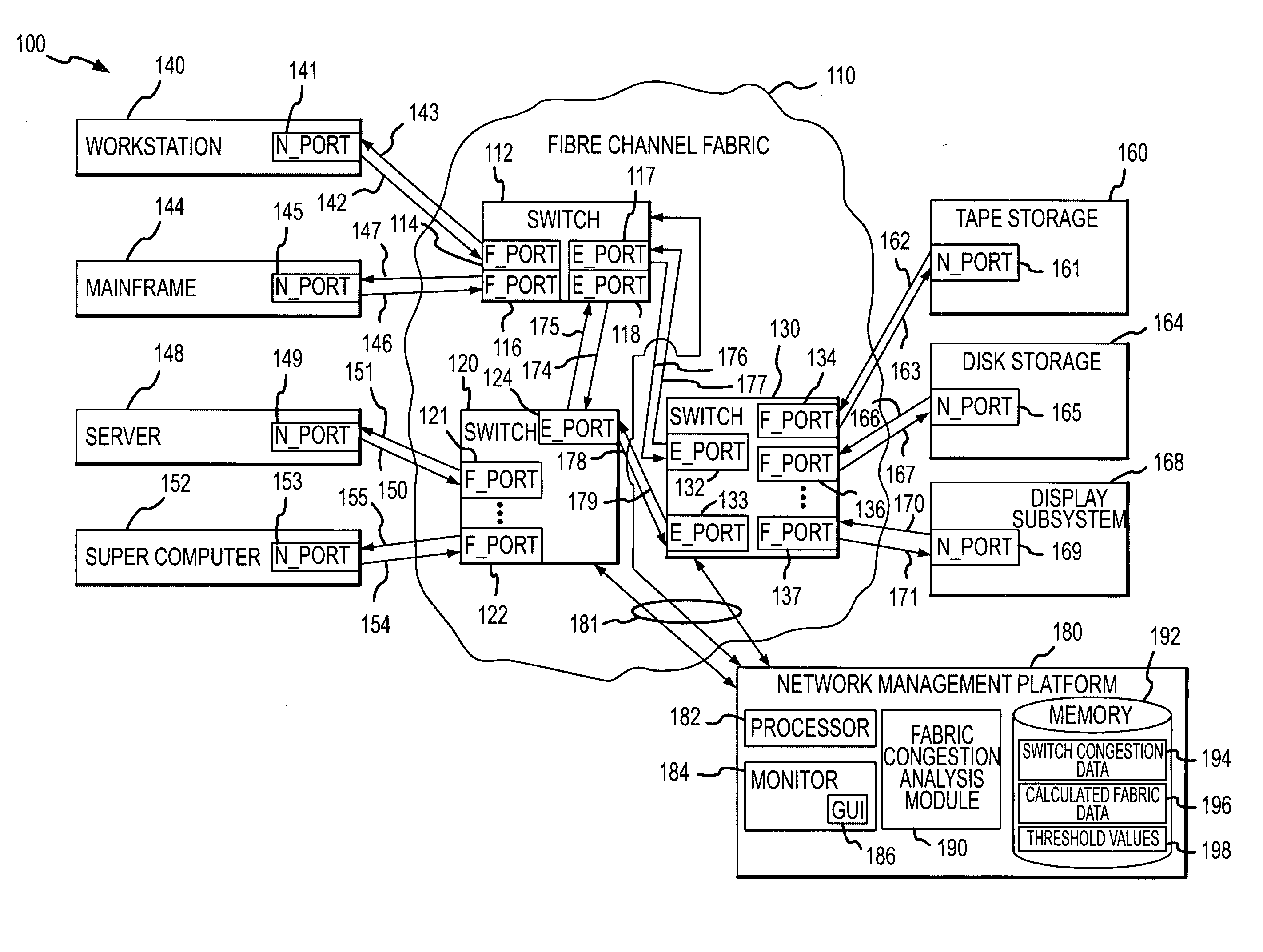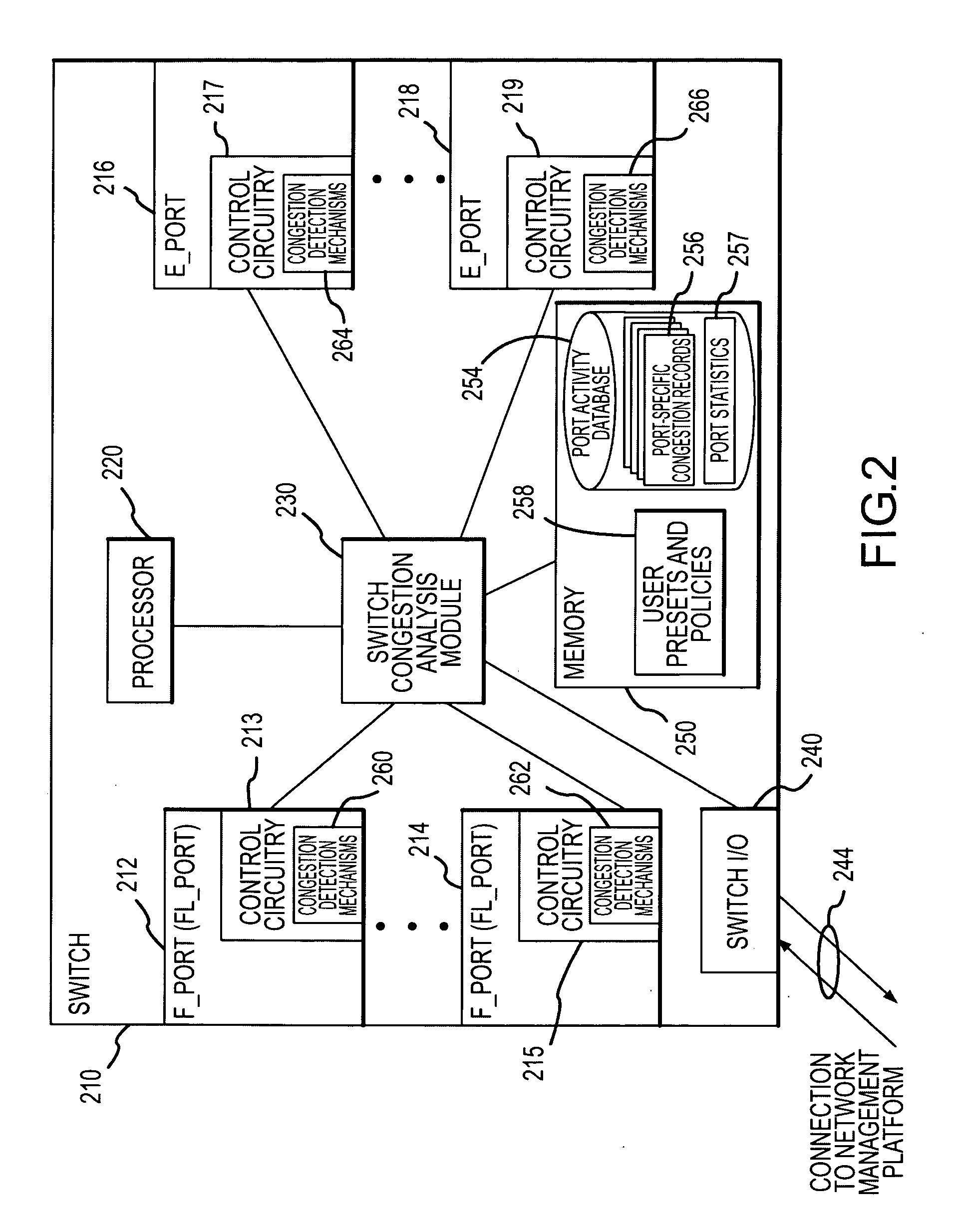Method of detecting and monitoring fabric congestion
a data storage network and fabric congestion technology, applied in the field of automatic methods and systems for monitoring and managing data storage networks, can solve the problems of backpressure congestion, major disruptions to user operations in data storage networks, fabric congestion, etc., and achieve the effect of effectively separating congestion points
- Summary
- Abstract
- Description
- Claims
- Application Information
AI Technical Summary
Benefits of technology
Problems solved by technology
Method used
Image
Examples
example 1
Congestion Statistics Calculations
[0085] The congestion management statistics are calculated by the switch module 230 once every “congestion management period” (by default, once per second) for each active port in the switch. Every period, the switch module 230 examines a set of statistics per port to determine if that port is showing any signs of congestion. If the gathered statistics meet the qualifications used to define congestion behavior, then the associated congestion management statistic is incremented for that port. If RX backpressure congestion is being detected by a port during a congestion management period, a second pass of gathering data is performed to help isolate the likely causes of the congestion with respect to the local switch.
[0086] When the switch module 230 is invoked, it collects the following statistics from the congestion detection mechanisms in the port control circuitry: (1) RX utilization percentage of 21 percent; (2) TX utilization percentage of 88 p...
example 2
Congestion Management Counter Threshold Alerts
[0088] Congestion Threshold Alerts (CTAs) are used in some cases by the switch congestion analysis module 230 to provide notification to management access points when a statistical counter in the congestion management statistical set 256 in the PAD 254 on the switch has exceeded a user-configurable threshold 258 over a set duration of time. A CTA may be configured by a user with the following exemplary values: (1) Port List / Port Type set at “All F_Ports”; (2) CTA Counter set at “TX Over-subscribed Periods”; (3) Increment Value set at “40”; and (4) Interval Time set at “10 minutes”. Thus, if the TX Over-subscribed period counter is incremented in the PAD entry for any F_Port 40 times or more within any 10 minute period then user notification is sent by the module 230 to the associated management interfaces.
example 3
Fabric Management and Congestion Source Isolation
[0089] In order to accurately depict a congested fabric view, the fabric congestion analysis module 190 on the management platform 180 keeps an accurate count of the changes in congestion management statistics over a set period of time for each port on the fabric. The module 190 also provides one or more threshold levels for each configuration statistic across the interval history time. These levels may be binary (e.g., congested / uncongested) or may be tiered (e.g., high, medium, or light (or no) congestion). For illustration purposes, Table 6 presents a model of an illustrative congestion management statistic threshold level table that may reside in memory 192 at 196 or elsewhere that is accessible by the fabric module 190.
TABLE 6Congestion Threshold LimitsThreshold Level(for 5 minute period -300 congestion periods)Port's RelationshipStatistical CounterMediumHighto Congestion SourceActionRXOversubscribedPeriod100200Congestion Sour...
PUM
 Login to View More
Login to View More Abstract
Description
Claims
Application Information
 Login to View More
Login to View More - R&D
- Intellectual Property
- Life Sciences
- Materials
- Tech Scout
- Unparalleled Data Quality
- Higher Quality Content
- 60% Fewer Hallucinations
Browse by: Latest US Patents, China's latest patents, Technical Efficacy Thesaurus, Application Domain, Technology Topic, Popular Technical Reports.
© 2025 PatSnap. All rights reserved.Legal|Privacy policy|Modern Slavery Act Transparency Statement|Sitemap|About US| Contact US: help@patsnap.com



